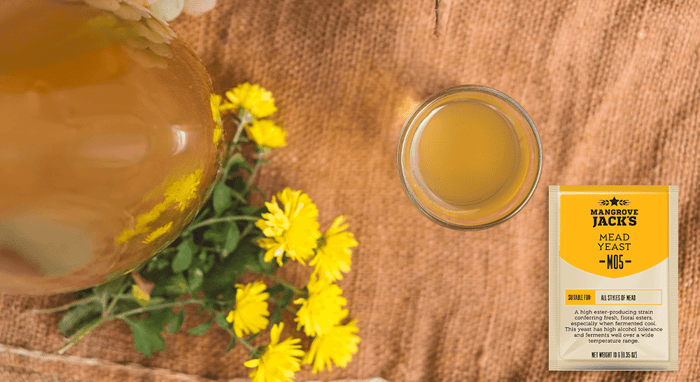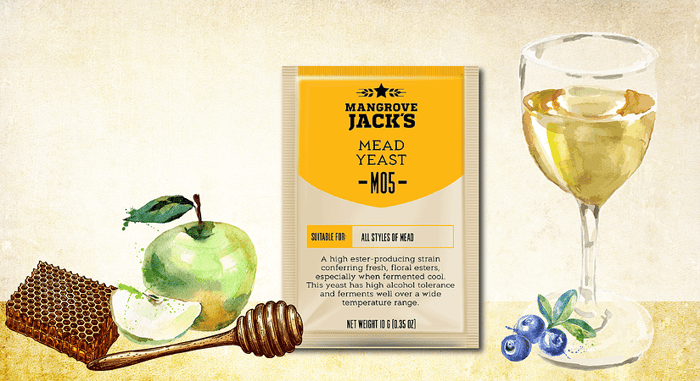Let's put what we've learned about mead this week to the test with this delicious traditional Dry Wildflower Mead recipe. This recipe delivers a delicate mead characteristic of the wild honey that finishes light and dry, and pairs well with delicate fruits and cheeses.
When selecting honey for a traditional blended mead, a large portion of the honey used should be non-descript honey (liquid honey) which will keep the costs down. For complexity, add a small portion of specialty honey (bush, Manuka, orange blossom).
Honey, while high in fermentable sugars, is low in minerals and nutrients. Couple that with its mild antiseptic properties and you get a tougher solution for the yeast to ferment in. All that means is that additional nutrients are needed during fermentation to make sure the yeast is happy and healthy; we recommend using Fermaid O and Go Ferm.
There are many yeast strains available for mead, these can be liquid or dry yeasts. Liquid yeasts will require a starter and nutrients, and dry yeast will require rehydration and nutrients before pitching. We recommend using Mangrove Jack's M05 Mead Yeast.
For calculations, we use the Mead Made Right TOSNA calculator.
Makes: 19 l
Approximate ABV: 9%
Please note that when using honey, the number of SG points added by an amount of honey will vary from honey to honey and season to season.
EQUIPMENT:
- Fermenter 25-30 l (6-8 gal)
- Hydrometer
- 250ml container
- Large container for water bath
- Thermometer
- Sanitiser
- Aluminium foil
- Stainless steel or plastic mash paddle
INGREDIENTS:
- 5 kg Liquid Honey
- 450 g Wildflower Honey
- 20 L Non-chlorinated water
- 18.14 g Fermaid O
- 12 g Mangrove Jack's M05 Mead Yeast
- 15 g Go Ferm
INSTRUCTIONS
1. Clean and sanitise all equipment.
2. If your yeast has been in the fridge or freezer, allow the yeast to warm to room temperature.
3. In a sanitised container, prepare a small amount (10ml per gram of yeast) of sterile non-chlorinated water. Place the sterile container with water in a water bath of either boiled or cold water to get your yeast water to 30-40 °C (86-104 °F).
4. Add 15 g Go Ferm, stir until dissolved.
5. Sprinkle the dry yeast over the top of the water, trying to avoid any large dry clumps then let sit for 15 minutes loosely covered with aluminium foil (to avoid foreign matter, and wild yeast falling into the mixture), then stir gently.
6. Gently stir again to form a cream, then let sit covered for another five minutes.
7. When the temperature of the cream is within 8 °C of your Must, pitch the cream into the fermenter (ideally as soon as possible).
a) Dilute honey into 10 l (3 gal) of warm <55 °C (131 °F)
b) Fill your fermenter with water to 19 L (5 gal) volume
c) Pitch the yeast and ferment in low 16 °C (62 °F)
d) Follow TOSNA nutrient addition schedule
i) Add yeast nutrients at 24-hours after yeast pitch.
ii) At the 48 and 72 hour mark, add yeast nutrients.
iii) Add the final nutrient addition on the 7th day after yeast pitch or when fermentation has reached its 1/3 sugar break (SG = 1.046), whichever comes first.
8. Degas twice a day by stirring the Musk gently until 1/3 sugar break to release CO2
9. Once fermentation has ceased, rack to secondary fermenter.
10. Age until clear or add clarifying agent.
11. Keg or bottle mead.




